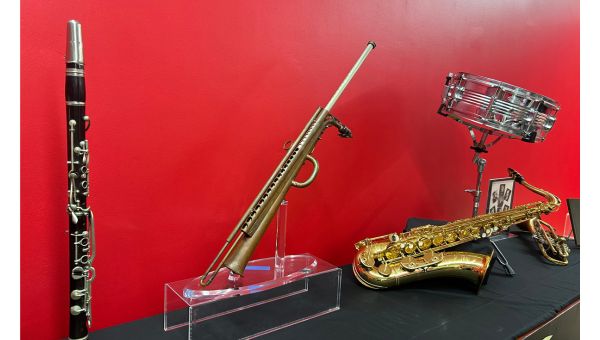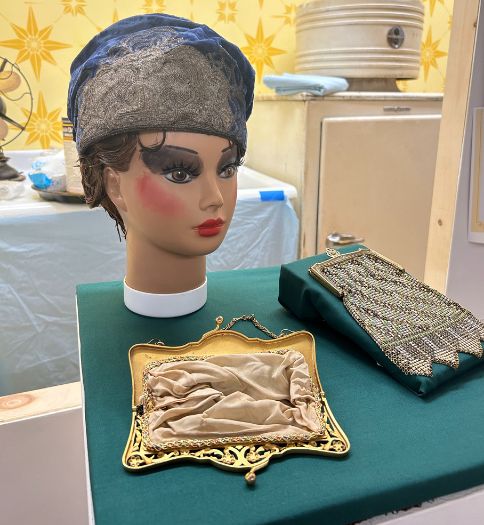Museum of Anthropology Opens “Roaring in Secret: Subversion and Change in the 1920s”
 On Friday, November 15, at 6 p.m., the West Chester University Museum of Anthropology and Archaeology opens its newest and boldest exhibition to date: “Roaring in Secret: Subversion and
Change in the 1920s.” A WCU student jazz band will entertain guests and visitors are
encouraged to come in period clothing.
On Friday, November 15, at 6 p.m., the West Chester University Museum of Anthropology and Archaeology opens its newest and boldest exhibition to date: “Roaring in Secret: Subversion and
Change in the 1920s.” A WCU student jazz band will entertain guests and visitors are
encouraged to come in period clothing.
Under the leadership of Museum Director Dr. Michael A. Di Giovine, professor of anthropology and museum studies, and Tom Haughey, associate professor of theatre, 15 undergraduate and graduate museum studies students worked for nearly a year to create an immersive and engaging exhibition that explores the simultaneously secret and subversive nature of the 1920s — from its art, music, and literature to its technological inventions; from its economic boom to its bust; from suffrage to flapper culture; Prohibition and crime to immigration.
Visitors are invited into a stylized home from the 1920s where authentic artifacts illustrate the ways in which innovations, inventions, and pop cultural movements in the 1920s fostered lasting change in American society. Each room tells a story of a real person who lived during the 1920s: a flapper girl, a struggling immigrant, a middle-class boy. Everything seen inside is an authentic artifact from the period. They come from the families who loaned or donated their artifacts to the museum:
- Toys, flapper dresses, and books from the Schlendorf Vintage Collection, donated to the museum by Mary and Neil Schlendorf of Wyckoff, NJ.
- Rare phonographs, radios, and jewelry on loan from the Di Giovine-Harwood family of Langhorne, PA;
- Dresses, letters, and personal effects from the Morrill family of Portland, OR;
- Film equipment, photographs, and fashion from the Nammavong family of Upper Darby, PA.
- A luxurious, beaded flapper wedding dress on loan from Malena’s Vintage Boutique in West Chester Borough.
- Memorabilia tracing the 1927 transition of West Chester Normal School into West Chester State Teachers College are also on display.
But there’s more than meets the eye. Visitors are asked to find the secret passageway leading to a hidden speakeasy where crime bosses, crooked politicians, flappers, and even everyday citizens subverted the Prohibition rules banning alcohol and gambling.
Very rare and authentic artifacts are also in the speakeasy, such as bottles of unopened bootleg liquor, doctors’ prescriptions for medicinal whiskey, and a working 1920s slot machine. Never-before-seen photos from Dan Slater, author of The Incorruptibles: A True Story of Kingpins, Crime Busters, and the Birth of the American Underworld, will also be on display. Visitors can also try their hand at playing a real theremin, a 1920s instrument that uses electricity and magnetics to make its unique warbling sound.
 The Jazz Age is in full gear, and the speakeasy also features several authentic instruments
courtesy of the Hartenberger World Music Collection, including a rare Royal Slide
Saxophone, an instrument invented in the 1920s that is half trombone, half sax. Only
a few exist in the world, and this one is the only copper-plated one in existence.
The Jazz Age is in full gear, and the speakeasy also features several authentic instruments
courtesy of the Hartenberger World Music Collection, including a rare Royal Slide
Saxophone, an instrument invented in the 1920s that is half trombone, half sax. Only
a few exist in the world, and this one is the only copper-plated one in existence.
“This is by far the most ambitious exhibition we have ever mounted,” said Dr. Di Giovine. “In addition to curating more than 100 artifacts, some of them quite rare and quite large, the students wanted this to be immersive, as if you were stepping back in time. Our museum designer and co-instructor for the class, Tom Haughey, really got to work on making these ideas a reality. It’s no wonder that the exhibition takes on the feel of the theatrical set rather than a traditional, historical museum. This is largely his vision, and I couldn’t be happier with how it turned out.”
Mary Joy Moyer ’23, the museum’s graduate assistant curator, worked on previous exhibitions as a student curator and said that, with the new exhibition, she “learned more about the behind-the-scenes aspects of all the jobs there are. This includes helping with hard decision-making that every curator faces.” She supported the other student curators and interpreted her role as a liaison between them and Dr. Di Giovine to streamline the creative process and communication. Moyer earned her undergraduate degree at the University in history with minors in museum studies and criminal justice and is on track to earn her master’s in history in 2025.
The opening reception is Friday, November 15, from 6 to 8 p.m. in the Lower Gallery of the Museum of Anthropology and Archaeology in the Old Library at 775 S. Church Street. Prohibition-era refreshments and appetizers will be served. The exhibition runs through 2025.
The museum is open Monday through Friday, 9 a.m. to 4:30 p.m. during the academic year. Guided tours are available by appointment.
For more information, visit the WCU Museum of Anthropology and Archaeology.
